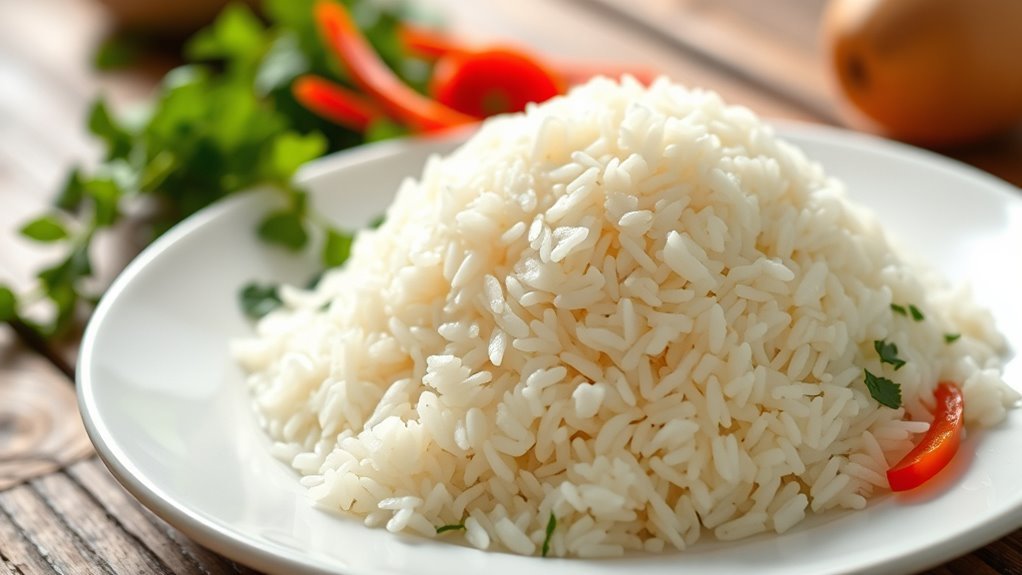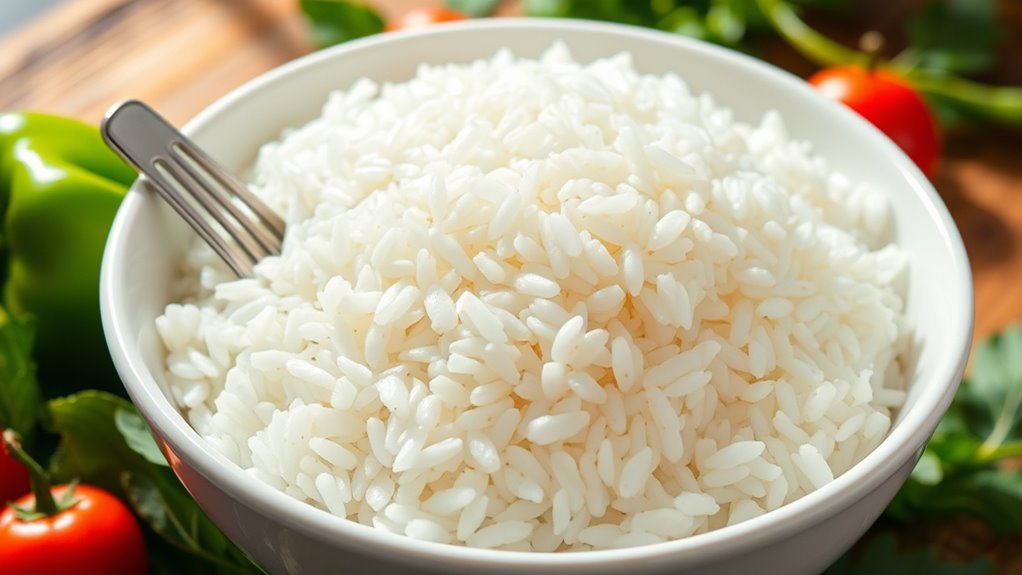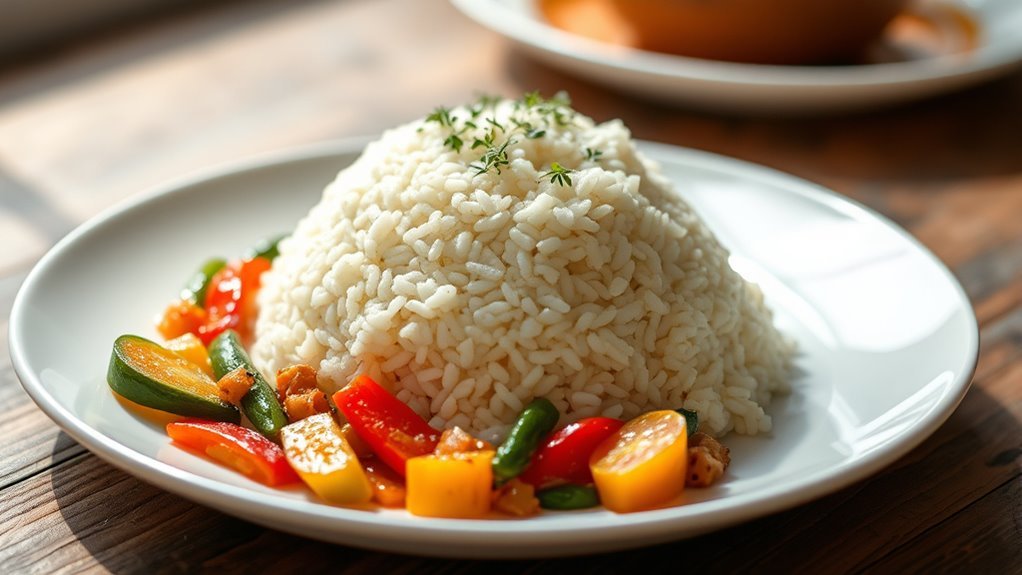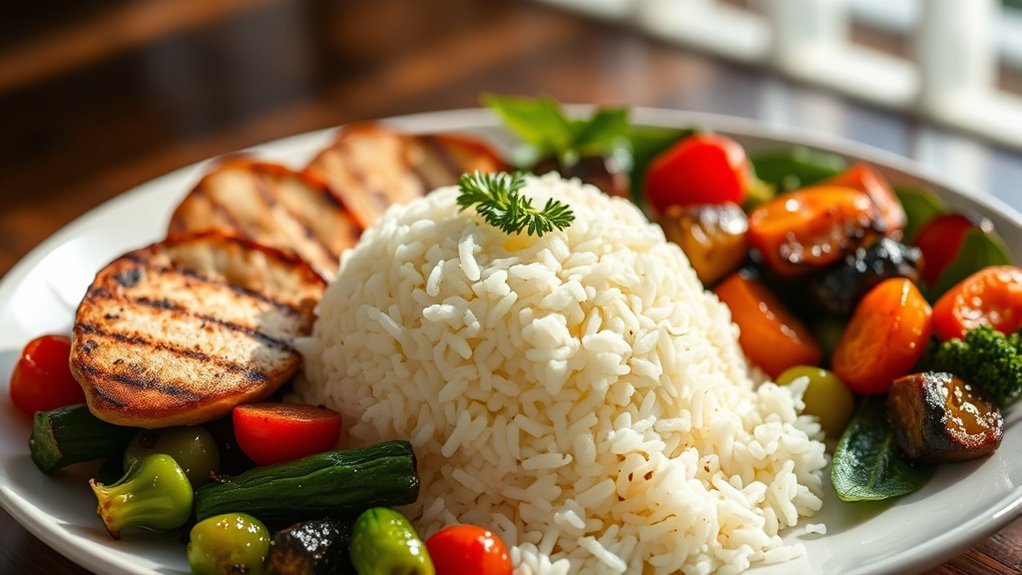You can’t eat traditional rice on a keto diet due to its high carbohydrate content, which can disrupt ketosis. White rice contains about 28 grams of carbs per 100 grams, while brown rice has around 23 grams. Both can spike blood sugar levels, leading to an insulin response that promotes fat storage. Instead, consider low-carb alternatives like cauliflower or shirataki rice, which can keep your meals satisfying while aligning with your dietary goals. More options await you!
Understanding the Keto Diet and Its Restrictions

Although the keto diet has gained popularity for its potential weight loss benefits, understanding its core principles and restrictions is necessary for success. At its heart, the keto diet emphasizes low carbohydrate intake, which typically means limiting carbs to about 20-50 grams per day. This restriction is essential for triggering ketosis, a metabolic state where your body burns fat for fuel instead of glucose. Embracing keto principles means prioritizing foods rich in healthy fats and proteins while minimizing carbs. It’s important to recognize that not all carbohydrates are created equal; even seemingly innocuous foods can push you over your carbohydrate limits, disrupting ketosis. By grasping these principles, you can navigate your dietary choices with the freedom to enjoy a healthier lifestyle.
Why Traditional Rice Is Not Keto-Friendly

Traditional rice is loaded with carbohydrates, which can greatly hinder your progress on a keto diet. Consuming it can lead to spikes in blood sugar levels, raising concerns about its glycemic impact. Understanding these factors is essential if you want to maintain ketosis effectively.
High Carb Content
Since rice is a staple in many diets worldwide, it can be surprising to realize that it doesn’t align with the ketogenic lifestyle. Traditional rice is high in carbohydrates, making it a poor choice for anyone aiming to maintain ketosis. For a clearer perspective on its carb counts, consider the following comparison:
| Type of Rice | Carb Count (per 100g) |
|---|---|
| White Rice | 28g |
| Brown Rice | 23g |
| Jasmine Rice | 26g |
| Basmati Rice | 25g |
| Wild Rice | 21g |
With such high glycemic levels, rice can spike your blood sugar, disrupting your keto goals. For true freedom in your diet, it’s best to seek alternatives that align with your low-carb needs.
Glycemic Impact Concerns
When you consume rice, your body rapidly converts the high carbohydrate content into glucose, leading to significant spikes in blood sugar levels. This is primarily due to rice’s high glycemic index, which measures how quickly carbohydrates affect blood sugar. Such spikes trigger an insulin response, prompting your body to store excess glucose as fat. For those following a keto diet, this can derail your efforts to maintain ketosis, where your body burns fat instead of carbohydrates for fuel. Eating rice may provide short-term energy, but the long-term effects on your blood sugar and insulin levels can hinder your freedom to achieve sustained weight loss and health benefits associated with a ketogenic lifestyle. Embracing low-carb alternatives is essential for success.
Low-Carb Rice Alternatives

When you’re looking for low-carb rice alternatives, cauliflower rice and shirataki noodles are two great options to evaluate. Cauliflower rice provides a nutrient-rich base while greatly cutting down on carbs, making it a versatile substitute in many dishes. Meanwhile, shirataki noodles offer a unique texture and virtually no calories, making them ideal for those strictly adhering to a keto lifestyle.
Cauliflower Rice Benefits
While you might miss traditional rice on a keto diet, cauliflower rice offers a nutritious and low-carb alternative that can satisfy your cravings. Cauliflower nutrition is impressive; it’s low in calories and carbs while being rich in vitamins C and K, fiber, and antioxidants. Swapping out rice for cauliflower can help you stay within your carb limits, allowing freedom in your meal choices. Plus, there are countless cauliflower recipes available that make it easy to incorporate this versatile veggie into your diet. From stir-fries to casseroles, you can enjoy familiar flavors without the guilt. Embracing cauliflower rice not only supports your health goals but also keeps your meals exciting and satisfying.
Shirataki Noodles Overview
If you’re looking for another low-carb alternative to traditional rice, shirataki noodles might be just what you need. Made from the konjac plant, these noodles are virtually calorie-free and packed with fiber, making them a popular choice for those on a keto diet. The shirataki noodles benefits include their ability to promote satiety and support digestive health. Preparing them is straightforward: rinse under cold water, boil for a couple of minutes, and they’re ready to absorb your favorite sauces or broths. Their neutral flavor allows them to complement various dishes, from stir-fries to soups. With the right preparation, shirataki noodles can be a satisfying addition to your low-carb meals, providing you with freedom in your dietary choices.
Cauliflower Rice: The Popular Choice
Cauliflower rice has emerged as a go-to alternative for those adhering to a keto diet, largely due to its low carbohydrate content and versatility in various dishes. You’ll find different cauliflower varieties, like white, purple, and orange, each offering unique flavors and nutritional benefits. This option not only helps you maintain your carb limits but also adds vibrant color to your plate.
When it comes to cooking methods, you can sauté, steam, or even microwave cauliflower rice, making it easy to incorporate into stir-fries, salads, or as a side dish. Its adaptability means you can enjoy it with various seasonings, allowing you to satisfy your taste buds without sacrificing your dietary goals. Embrace this healthy alternative, and enjoy the freedom it offers!
Shirataki Rice: A Unique Option
For those seeking an alternative to traditional rice on a keto diet, Shirataki rice stands out due to its extremely low carbohydrate content and unique texture. Made from konjac yam, it contains virtually no calories or carbs, making it a popular choice for keto enthusiasts. One of the primary shirataki benefits is its ability to add bulk to meals without impacting your macro goals. This versatile ingredient can be used in a variety of shirataki recipes, from stir-fries to casseroles, allowing you to enjoy your favorite dishes without guilt. Its mild flavor easily absorbs the tastes of accompanying ingredients, providing a satisfying meal experience. Embracing Shirataki rice can empower you to maintain your keto lifestyle while enjoying diverse, fulfilling meals.
Exploring Other Grain Substitutes
While Shirataki rice offers a fantastic alternative, there are several other grain substitutes worth exploring for anyone on a keto diet. You might find that some options not only fit your dietary needs but also come with added health benefits.
| Substitute | Carbs (per 100g) | Quinoa Benefits |
|---|---|---|
| Cauliflower Rice | 3g | Low in calories, high in fiber |
| Zucchini Noodles | 3g | Rich in vitamins and minerals |
| Riced Broccoli | 4g | Antioxidant properties |
| Palmini Rice | 2g | Low-calorie, made from hearts of palm |
| Barley Substitutes | 28g (regular) | Good for gut health (but higher in carbs) |
Experimenting with these options can help you maintain your keto lifestyle while enjoying diverse meals!
Creative Ways to Enjoy Rice Alternatives
When you’re looking to spice up your meals on a keto diet, experimenting with rice alternatives can lead to delicious and satisfying dishes. Consider zucchini noodles or riced vegetables for a fresh take on the classic rice bowl. Konjac rice offers a low-calorie option with a similar texture, while broccoli rice adds nutritional value and flavor. If you’re craving something heartier, try eggplant couscous, which can absorb flavors beautifully. For added protein, quinoa alternatives made from seeds or nut flour can enhance your meals without compromising your carb goals. By mixing these options creatively, you can maintain variety and excitement in your diet, allowing you to enjoy meals that feel indulgent while staying true to your keto lifestyle.
Tips for Incorporating Rice Alternatives Into Meals
Incorporating rice alternatives into your meals can be both simple and rewarding, especially as they offer unique textures and flavors that can elevate your dishes. For effective meal prep, consider options like cauliflower rice, which can absorb flavors well and provide a low-carb base for stir-fries and curries. Zucchini noodles are another great substitute, perfect for pairing with sauces in rice recipes. When experimenting, try mixing various alternatives to create diverse textures—like blending cauliflower and broccoli rice. Don’t forget to season generously; herbs and spices can transform your meals. Keeping a variety of alternatives on hand allows you to stay flexible and creative, ensuring you can enjoy satisfying meals while maintaining your keto lifestyle.
Balancing Cravings and Staying on Track With Keto
Cravings can often derail your commitment to a keto diet, especially when you’re surrounded by high-carb temptations. Effective craving management is essential for staying on track. Start by prioritizing meal planning; having keto-friendly meals ready helps you resist impulsive choices. Incorporate satisfying, low-carb snacks like nuts or cheese to curb hunger between meals.
Understanding your triggers can also aid in managing cravings—whether it’s stress, boredom, or social situations. Instead of giving in, find alternative activities that redirect your focus. Embrace your freedom by allowing occasional indulgences, but plan them wisely. Balancing cravings with structured meal planning not only keeps you aligned with your goals but also enhances your overall experience on the keto journey.


